九年级英语新目标初中英语语法知识大全辅导
- 格式:doc
- 大小:76.00 KB
- 文档页数:31
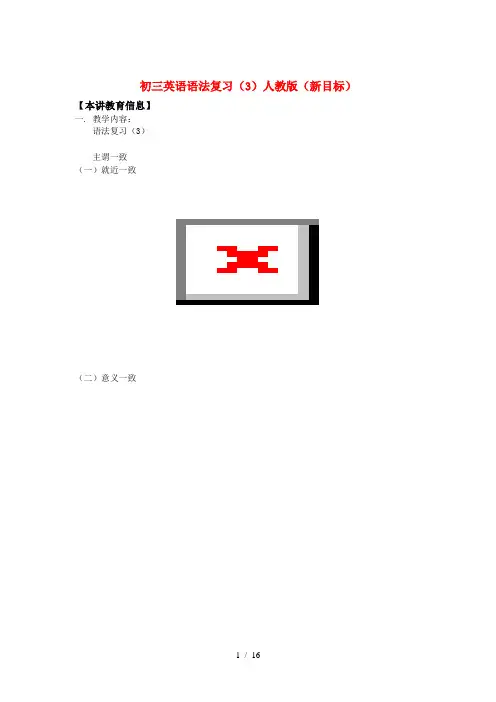
初三英语语法复习(3)人教版(新目标)【本讲教育信息】一. 教学内容:语法复习(3)主谓一致(一)就近一致(二)意义一致反意疑问句感叹句两组重要连词用法区别从句连词区别例句when 表示某个具体的时间,可以指一段时间,也可指一点时间,既可表示一时性的动作,又可表示持续的动作。
有时强调预料之外突然发生。
When you arrive in London, pleasegive us a call.When he was having his breakfast,he heard the door bell ring.I was just coming along to see youwhen I ran into Wilson.as 所表示的动作与主句动作同时发生,具有延续的含义,一般与延续性动词连用。
As time went on, he grew more andmore impatient.As we walked, we talked.时间状语从句while 只表示持续性的动作或状态,不能表示一时性或短暂的动作。
有时有对比的含义,意为“然而”。
While she was reading a novel, hermother was cooking the dinner.Some people waste food while othershaven’t enough.because 表示原因的语气最强,常用于回答以疑问词“why”引导的疑问句。
because从句一般位于主句后面。
The engine stopped running becausethe fuel was finished.He is absent today because he is ill.for 表示一种推理或解释,或用作附加说明,而不是指理由或原因,语气最弱,一般不放在句首,意为“因为,其理由是”。
The day breaks, for the birds aresinging.There must be no one in the house,for the door is closed.as 表示十分明显的原因,说明一般的因果关系,着重点在主句。
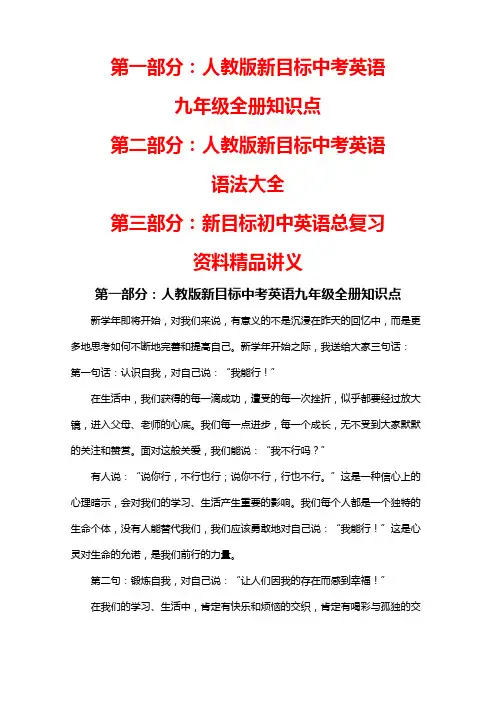
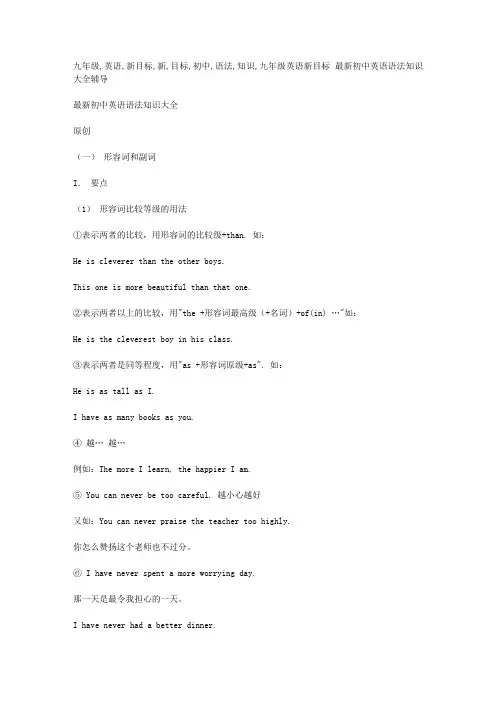
九年级,英语,新目标,新,目标,初中,语法,知识,九年级英语新目标最新初中英语语法知识大全辅导最新初中英语语法知识大全原创(一)形容词和副词I.要点(1)形容词比较等级的用法①表示两者的比较,用形容词的比较级+than. 如:He is cleverer than the other boys.This one is more beautiful than that one.②表示两者以上的比较,用"the +形容词最高级(+名词)+of(in) …"如:He is the cleverest boy in his class.③表示两者是同等程度,用"as +形容词原级+as". 如:He is as tall as I.I have as many books as you.④ 越… 越…例如:The more I learn, the happier I am.⑤ You can never be too careful. 越小心越好又如:You can never praise the teacher too highly.你怎么赞扬这个老师也不过分。
⑥ I have never spent a more worrying day.那一天是最令我担心的一天。
I have never had a better dinner.这是我吃过的最好的一顿饭。
⑦ My English is no better than yours.我的英语和你的英语都不怎么样。
例2 ____ the worse I seem to be.A When I take more medicineB The more medicine I takeC Taking more of the medicineD More medicine taken解析:该题正确答案为B。
"the+形容词比较级+… , the +形容词比较级+…"意为越…,越…。
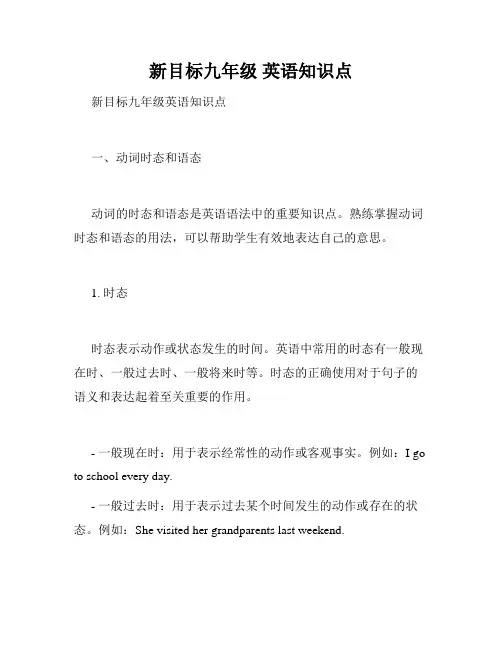
新目标九年级英语知识点新目标九年级英语知识点一、动词时态和语态动词的时态和语态是英语语法中的重要知识点。
熟练掌握动词时态和语态的用法,可以帮助学生有效地表达自己的意思。
1. 时态时态表示动作或状态发生的时间。
英语中常用的时态有一般现在时、一般过去时、一般将来时等。
时态的正确使用对于句子的语义和表达起着至关重要的作用。
- 一般现在时:用于表示经常性的动作或客观事实。
例如:I go to school every day.- 一般过去时:用于表示过去某个时间发生的动作或存在的状态。
例如:She visited her grandparents last weekend.- 一般将来时:用于表示将来某个时间会发生的动作。
例如:We will have a party next Friday.2. 语态语态表示主语和谓语之间的关系。
英语中常用的语态有主动语态和被动语态。
了解和正确运用语态可以使句子更加丰富和灵活。
- 主动语态:表示主语是主动执行动作的情况。
例如:He reads books every night.- 被动语态:表示主语是动作的承受者,即动作是由别人执行的情况。
例如:The book was written by Shakespeare.二、名词性从句名词性从句是由一个词或一个句子充当名词的成分。
在复合句中,它可以担当主语、宾语、表语和同位语等成分。
了解名词性从句的用法能够使句子的表达更加准确和丰富。
1. 名词性从句作主语名词性从句作主语时,它所表示的意思是句子的主要内容。
- What he said is true. (宾语从句作主语)- If it rains, we will stay at home. (条件从句作主语)- That he is late again makes me angry. (主语从句作主语)2. 名词性从句作宾语名词性从句作宾语时,它所表示的意思是主句的动作或状态所作用的对象。
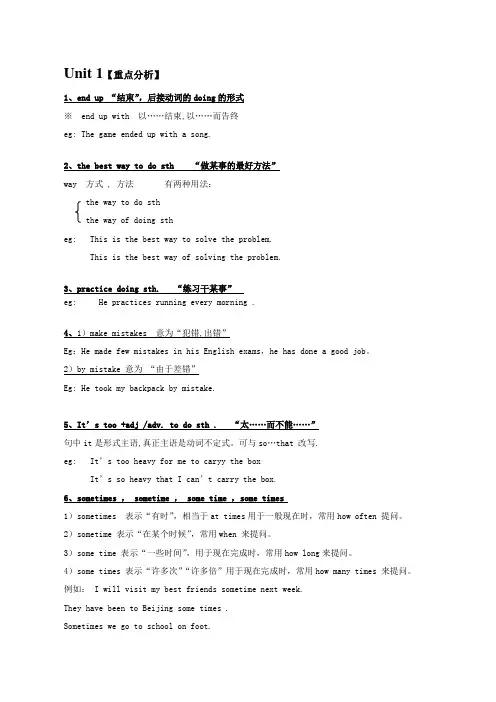
Unit 1【重点分析】1、end up “结束”,后接动词的doing的形式※ end up with 以……结束,以……而告终eg: The game ended up with a song.2、the best way to do sth “做某事的最好方法”way 方式 , 方法有两种用法:the way to do sththe way of doing stheg: This is the best way to solve the problem.This is the best way of solving the problem.3、practice doing sth. “练习干某事”eg: He practices running every morning .4、1)make mistakes 意为“犯错,出错”Eg:He made few mistakes in his English exams,he has done a good job。
2)by mistake 意为“由于差错”Eg: He took my backpack by mistake.5、It’s too +adj /adv. to do sth . “太……而不能……”句中it是形式主语,真正主语是动词不定式。
可与so…that 改写.eg: It’s too heavy for me to caryy the boxIt’s so heavy that I can’t carry the box.6、sometimes , sometime , some time ,some times1)sometimes 表示“有时”,相当于at times用于一般现在时,常用how often 提问。
2)sometime 表示“在某个时候”,常用when 来提问。
3)some time 表示“一些时间”,用于现在完成时,常用how long来提问。
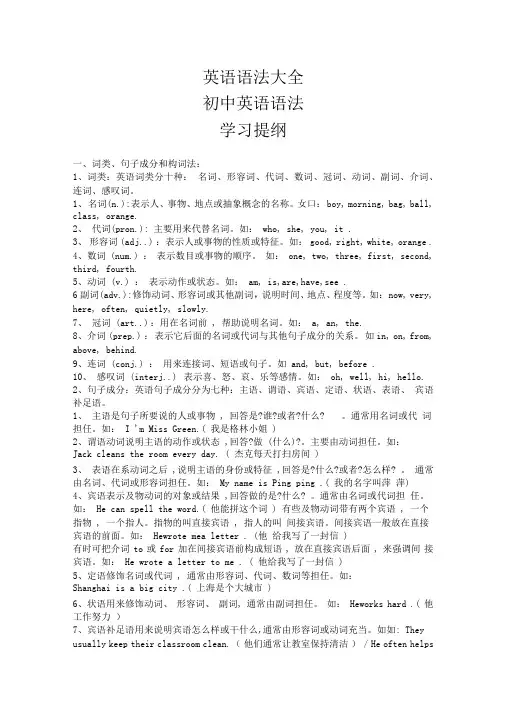
英语语法大全初中英语语法学习提纲一、词类、句子成分和构词法:1、词类:英语词类分十种:名词、形容词、代词、数词、冠词、动词、副词、介词、连词、感叹词。
1、名词(n.):表示人、事物、地点或抽象概念的名称。
女口:boy, morning, bag, ball, class, orange.2、代词(pron.): 主要用来代替名词。
如: who, she, you, it .3、形容词(adj..) :表示人或事物的性质或特征。
如:good, right, white, orange .4、数词 (num.) :表示数目或事物的顺序。
如: one, two, three, first, second, third, fourth.5、动词 (v.) :表示动作或状态。
如: am, is,are,have,see .6副词(adv.):修饰动词、形容词或其他副词,说明时间、地点、程度等。
如:now, very, here, often, quietly, slowly.7、冠词 (art..) :用在名词前 , 帮助说明名词。
如: a, an, the.8、介词(prep.) :表示它后面的名词或代词与其他句子成分的关系。
如in, on, from, above, behind.9、连词 (conj.) :用来连接词、短语或句子。
如 and, but, before .10、感叹词 (interj..) 表示喜、怒、哀、乐等感情。
如: oh, well, hi, hello.2、句子成分:英语句子成分分为七种:主语、谓语、宾语、定语、状语、表语、宾语补足语。
1、主语是句子所要说的人或事物 , 回答是?谁?或者?什么? 。
通常用名词或代词担任。
如: I 'm Miss Green.( 我是格林小姐 )2、谓语动词说明主语的动作或状态 ,回答?做 (什么)?。
主要由动词担任。
如:Jack cleans the room every day. ( 杰克每天打扫房间 )3、表语在系动词之后 ,说明主语的身份或特征 ,回答是?什么?或者?怎么样? 。
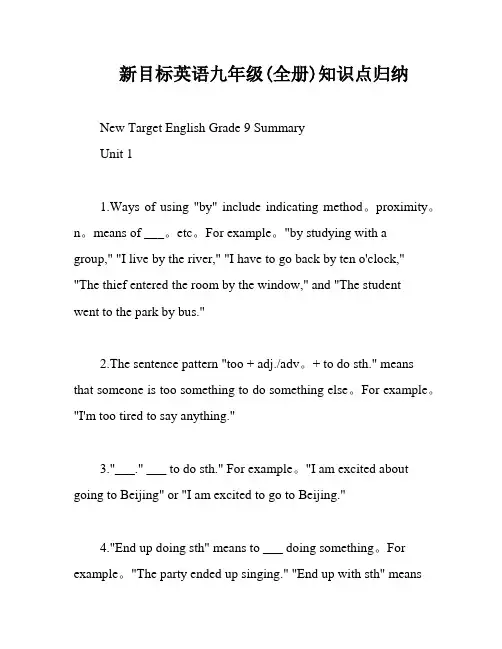
新目标英语九年级(全册)知识点归纳New Target English Grade 9 SummaryUnit 11.Ways of using "by" include indicating method。
proximity。
n。
means of ___。
etc。
For example。
"by studying with a group," "I live by the river," "I have to go back by ten o'clock," "The thief entered the room by the window," and "The studentwent to the park by bus."2.The sentence pattern "too + adj./adv。
+ to do sth." means that someone is too something to do something else。
For example。
"I'm too tired to say anything."3."___." ___ to do sth." For example。
"I am excited about going to Beijing" or "I am excited to go to Beijing."4."End up doing sth" means to ___ doing something。
For example。
"The party ended up singing." "End up with sth" meansto end with something。
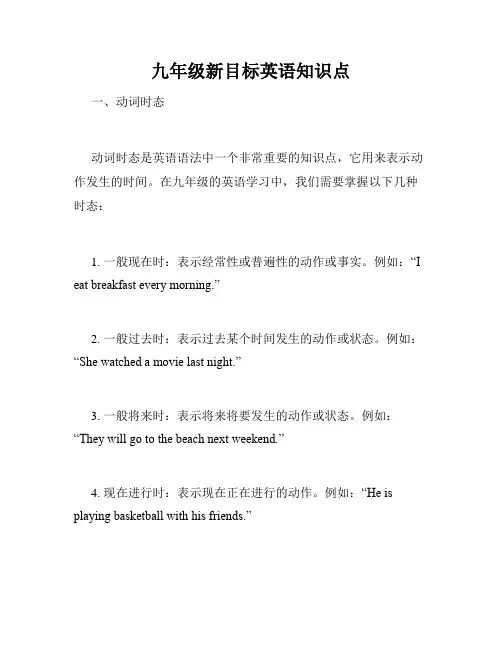
九年级新目标英语知识点一、动词时态动词时态是英语语法中一个非常重要的知识点,它用来表示动作发生的时间。
在九年级的英语学习中,我们需要掌握以下几种时态:1. 一般现在时:表示经常性或普遍性的动作或事实。
例如:“I eat breakfast every morning.”2. 一般过去时:表示过去某个时间发生的动作或状态。
例如:“She watched a movie last night.”3. 一般将来时:表示将来将要发生的动作或状态。
例如:“They will go to the beach next weekend.”4. 现在进行时:表示现在正在进行的动作。
例如:“He is playing basketball with his friends.”5. 过去进行时:表示过去某个时间正在进行的动作。
例如:“We were studying English when the electricity went out.”6. 现在完成时:表示过去发生并且对当前有影响或结果的动作或状态。
例如:“I have finished my homework, so I can go out and play.”7. 过去完成时:表示过去某个时间或动作发生在另一个过去时间或动作之前。
例如:“By the time they arrived, we had already left.”二、被动语态被动语态在英语中是非常常用的。
它用来强调动作的接受者而不是执行者。
被动语态的构成为:助动词(am/is/are/was/were)+过去分词。
例如:“The book was written by Mark Twain.”被动语态的使用具有一定的规则,但是总体来说,只要将句子中的主语变为动作的接受者,并且使用相应的被动语态形式,就可以构成被动语态。
三、名词性从句名词性从句在九年级英语学习中也是一个重要的知识点。
名词性从句可以在句子中充当主语、宾语、表语或同位语。
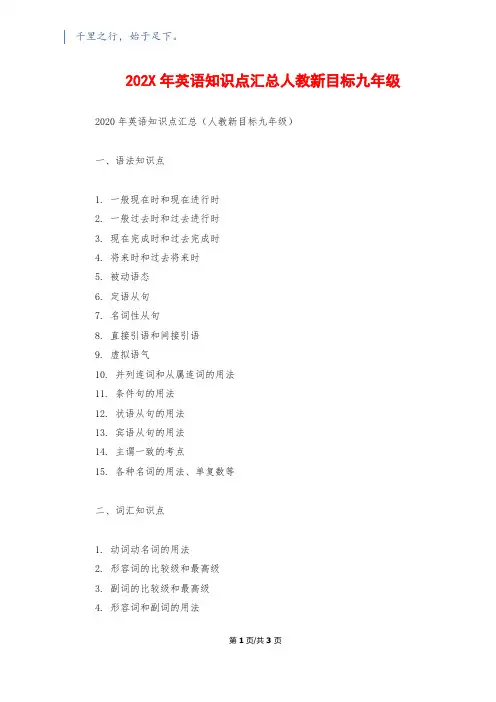
千里之行,始于足下。
202X年英语知识点汇总人教新目标九年级2020年英语知识点汇总(人教新目标九年级)一、语法知识点1. 一般现在时和现在进行时2. 一般过去时和过去进行时3. 现在完成时和过去完成时4. 将来时和过去将来时5. 被动语态6. 定语从句7. 名词性从句8. 直接引语和间接引语9. 虚拟语气10. 并列连词和从属连词的用法11. 条件句的用法12. 状语从句的用法13. 宾语从句的用法14. 主谓一致的考点15. 各种名词的用法、单复数等二、词汇知识点1. 动词动名词的用法2. 形容词的比较级和最高级3. 副词的比较级和最高级4. 形容词和副词的用法第1页/共3页锲而不舍,金石可镂。
5. 复合词的构成和词义6. 介词短语的用法7. 词义辨析8. 词组和固定搭配9. 常用短语和习惯用法10. 习惯用法的辨析11. 词形转换和派生词的用法12. 各种词类的用法13. 词汇的辨析和用法三、阅读理解1. 认字识词2. 词义猜测3. 阅读顺序4. 推理判断5. 阅读理解题型6. 文章主旨大意7. 文章结构8. 文章出处和作者意图9. 文章的背景和情节10. 文章的观点和态度四、写作技巧1. 书信的格式和写作方法2. 日记的写作技巧和模板3. 描写人物和事物的方法和技巧4. 叙事文的基本结构和写作方法5. 说明文的写作结构和方法千里之行,始于足下。
6. 议论文的写作方法和写作要点7. 描写环境的方法和技巧8. 写人的方法和技巧9. 文章的开头结尾的写作方法10. 给与建议和提出要求的写作方法五、口语和听力技巧1. 听力技巧和短文理解2. 表达观点和意见的口语表达3. 描述个人经历和事件的口语表达4. 提问和回答的技巧和表达方式5. 谈论过去和将来的口语表达6. 演讲和口头报告的技巧和写作方法7. 各种口语问答的技巧和表达方式8. 倾听和回答问题的技巧和方法9. 讨论和辩论的技巧和写作方法10. 口语表达的流利程度和准确性第3页/共3页。
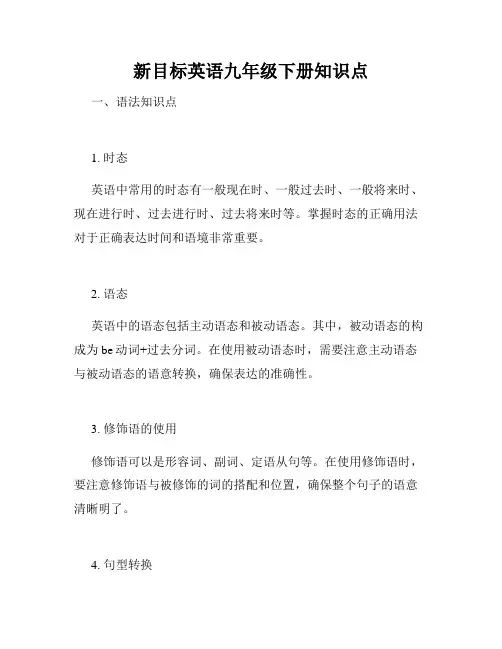
新目标英语九年级下册知识点一、语法知识点1. 时态英语中常用的时态有一般现在时、一般过去时、一般将来时、现在进行时、过去进行时、过去将来时等。
掌握时态的正确用法对于正确表达时间和语境非常重要。
2. 语态英语中的语态包括主动语态和被动语态。
其中,被动语态的构成为be动词+过去分词。
在使用被动语态时,需要注意主动语态与被动语态的语意转换,确保表达的准确性。
3. 修饰语的使用修饰语可以是形容词、副词、定语从句等。
在使用修饰语时,要注意修饰语与被修饰的词的搭配和位置,确保整个句子的语意清晰明了。
4. 句型转换句型转换是英语学习中的一项重要内容,它可以帮助我们加深对句子结构和语法规则的理解。
在句型转换中,需要注意句子的主谓一致性、句子结构的完整性等方面的问题。
5. 宾语从句和名词性从句宾语从句和名词性从句可以作为主句的宾语或补语,并且在意义上相当于一个名词。
掌握如何构建和使用宾语从句和名词性从句是十分重要的。
二、词汇知识点1. 同义词和反义词同义词和反义词是指在意义上相近或相反的词语。
通过扩大、丰富自己的词汇量,可以更准确、灵活地表达自己的意思。
2. 词汇拓展英语中有很多词汇是可以进行拓展的。
通过拓展词汇,可以使表达更具体、更生动。
3. 词组和短语词组和短语是指多个单词组合在一起有特定含义的使用形式。
通过学习和掌握一些常用的词组和短语,可以提高语言的表达能力。
4. 词根和词缀词根和词缀是构成单词的基本元素,通过学习和了解常见的词根和词缀,可以帮助我们理解和记忆更多的词汇。
三、阅读技巧1. 掌握上下文推测词义在阅读时,经常会遇到一些生词,可以通过上下文来推测词义,提高阅读的流畅性和效率。
2. 总结归纳段落大意在阅读文章时,要注意整体把握,理解每个段落的主题,并进行总结归纳,有助于更好地理解和记忆文章内容。
3. 注意信息的获取和理解在阅读时,要注意信息的获取和理解,尤其是对于细节和重要信息的把握,提高对文章细节的敏感度。
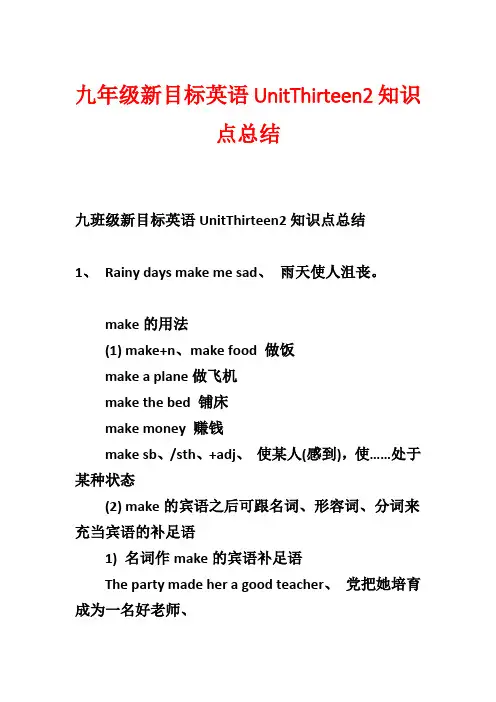
九年级新目标英语UnitThirteen2知识点总结九班级新目标英语UnitThirteen2知识点总结1、Rainy days make me sad、雨天使人沮丧。
make的用法(1) make+n、make food 做饭make a plane做飞机make the bed 铺床make money 赚钱make sb、/sth、+adj、使某人(感到),使……处于某种状态(2) make的宾语之后可跟名词、形容词、分词来充当宾语的补足语1) 名词作make的宾语补足语The party made her a good teacher、党把她培育成为一名好老师、2) 形容词作make的宾语补足语如:Soccer makes me crazy、足球使我疯狂。
The soft music makes Tina sleepy、轻柔的音乐使Tina快睡着了。
Waiting for her made me angry、我很生气一直等着她。
可用到的形容词有:happy,pleased,surprised,angry,annoyed,sad,upset,unhappy,worried,anxious,excited,relaxed,stressed out,tense,calm,scared,comfortable,sick…3) 分词作make的宾语补足语如:I made myself understood by all the students、You must make yourself respected、(3) make sb、/sth、+do… 使某人做某事(不能带不定式符号to)如:Wars make the peace go away、战争使和平远离。
注意:当make用于被动语态时,必须带不定式符号to、如:We were made to work all night、我们被迫日夜工作。
2010最新初中英语语法知识大全原创(一)形容词和副词I.要点A.形容词1、形容词的用法形容词是用来修饰、描绘名词的,通常在句中作定语、表语或宾补,有时还可作状语。
如:He is honest and hardworking.I found the book interesting.某些形容词与定冠词连用表示一类人作主语时,谓语通常用复数形式。
如:The rich and the poor live in different parts of the city.The English like to be with their families.多个形容词作定语修饰名词的顺序:冠词+序数词+基数词+性质状态(描述性)+形状大小+新旧老少+颜色+国籍+材料+名词。
如:the second five interesting big new red Chinese wall papers.2、形容词比较等级的形式(1)规则形式一般说来,单音节词及少数双音节词在后加-er; --est 来构成比较级和最高级;其他双音节词及多音节词在前加more, most.如:great-greater-greatestbusy-busier-busiestimportant-more important-(the)most important(2)不规则形式good (well)-better-bestbad (ill)-worse-worstmany (much)-more-mostlittle-less-least(3)形容词比较等级的用法①表示两者的比较,用形容词的比较级+than. 如:He is cleverer than the other boys.This one is more beautiful than that one.②表示两者以上的比较,用"the +形容词最高级(+名词)+of(in) …"如:He is the cleverest boy in his class.③表示两者是同等程度,用"as +形容词原级+as". 如:He is as tall as I.I have as many books as you.④越… 越…例如:The more I learn, the happier I am.⑤You can never be too careful. 越小心越好又如:You can never praise the teacher too highly.你怎么赞扬这个老师也不过分。
新目标版九年级英语全册知识点九年级英语Unit11. by + doing通过……方式如:by studying with a groupby 还可以表示:“在…旁”、“靠近”、“在…期间”、“用、”“经过”、“乘车”等如:I live by the river.I have to go back by ten o’clock.The thief entered the room by the window.The student went to park by bus.2. talk about 谈论,议论,讨论如:The students often talk about movie after class. 学生们常常在课后讨论电影。
talk to sb. === talk with sb. 与某人说话3. 提建议的句子:①What/ how about +doing sth.?如:What/ How about going shopping?②Why don’t you + do sth.?如:Why don’t you go shopping?③Why not + do sth. ? 如:Why not go shopping?④Let’s + do sth. 如:Let’s go shopping⑤Shall we/ I + do sth.?如:Shall we/ I go shopping?4. a lot 许多常用于句末如:I eat a lot. 我吃了许多。
5. too…to 太…而不能常用的句型too+adj./adv. + to do sth.如:I’m too tired to say anything. 我太累了,什么都不想说。
6. aloud, loud与loudly的用法三个词都与"大声"或"响亮"有关。
①aloud是副词,重点在出声能让人听见,但声音不一定很大,常用在读书或说话上。
九年级英语新目标2010最新初中英语语法知识大全辅导2010最新初中英语语法知识大全原创(一)形容词和副词I.要点(1)形容词比较等级的用法①表示两者的比较,用形容词的比较级+than. 如:He is cleverer than the other boys.This one is more beautiful than that one.②表示两者以上的比较,用"the +形容词最高级(+名词)+of(in) …"如:He is the cleverest boy in his class.③表示两者是同等程度,用"as +形容词原级+as". 如:He is as tall as I.I have as many books as you.④ 越… 越…例如:The more I learn, the happier I am.⑤ You can never be too careful. 越小心越好又如:You can never praise the teacher too highly.你怎么赞扬这个老师也不过分。
⑥ I have never spent a more worrying day.那一天是最令我担心的一天。
I have never had a better dinner.这是我吃过的最好的一顿饭。
⑦ My English is no better than yours.我的英语和你的英语都不怎么样。
例2 ____ the worse I seem to be.A When I take more medicineB The more medicine I takeC Taking more of the medicineD More medicine taken解析:该题正确答案为B。
"the+形容词比较级+… , the +形容词比较级+…"意为越…,越…。
该句意为:吃的药越多,我的病越是加重。
例3"I haven't been to London yet"."I haven't been there ____".A tooB alsoC eitherD neither解析:该题正确答案为C。
A和B都用于肯定句中。
D-neither本身意为否定"两者都不",而C-either则用于否定句中,意为"也"。
(二)介词I.要点(2) between, among(表位置)between仅用于二者之间,但说三者或三者以上中的每两个之间的相互关系时,也用between, 如I'm sitting between Tom and Alice.The village lies between three hills.among用于三者或三者以上之间。
如:He is the best among the students.(3) beside, besidesbeside意为"在…旁边",而besides意为"除…之外"。
如:He sat beside me.What do you want besides this?(4)in the tree, on the treein the tree 指动物或人在树上,而on the tree 指果实、树叶长在树上(5)on the way, in the way, by the way, in this wayon the way 指在路上 in the way 指挡道by the way 指顺便问一句 in this way 用这样的方法(7)in the morning, on the morningin the morning 是一般说法 on the morning 特指某一天的早晨II.例题例1 Do you know any other foreign language____ English?A exceptB butC besideD besides解析:A、B两项except等于but,意为"除了…",C-beside意为"在…旁边",不符合题意。
而D-besides, 意为"除了…之外,还有"。
所以该题正确答案为D。
该题意为:除了英语外,你还知道别的语言吗?例2 He suddenly returned ____ a rainy night.A onB atC inD during解析:我们均知道,at night这一短语,但如果night前有修饰词,表具体的夜晚,则要用介词on来修饰,故该题正确答案为A。
例3 I'm looking forward ____your letter.A toB inC atD on解析:该题正确答案为A。
look forward to 为固定搭配,意为"期望、盼望"。
(三)连词I.要点1、连词的种类(1)并列连词用来连接并列关系的词、短语或分句,如both…and, either…or, neither…nor等。
(2)从属连词用来引导从句,如that, if, whether, when, after, as soon as等。
除了从属连词(引导状语从句)外,还有其它可以用来引导从句的词类。
它们是连接代词和连接副词(引导名词性从句),关系代词和关系副词(引导定语从句)。
2、常用连词举例(2) both…and 和,既…也…Both my parents and I went there.(4) either…or 或…或…,要么…要么…Either you're wrong, or I am.(7) neither…nor 既不…也不Neither my parents nor my aunt agrees with you.(8) not only…but(also) 不但…而且…He not only sings well, but also dances well.(12) as soon as 一…就I'll tell him as soon as I see him.(14)unless 除非,如果不I won't go unless it is fine tomorrow.(15)until 直到…He didn't leave until eleven. (瞬间动词用于not… until 结构)He stayed there until eleven.(16)while 当…时候,而 (表示对比)While I stayed there, I met a friend of mine. (while后不可用瞬间动词)My pen is red while his is blue.(18)since自从…I have lived here since my uncle left.(19)hardly… when 一… 就I had hardly got to the station when the train left.(20)as far as 就… 来说As far as I know, that country is very small.You may walk as far as the lake. (一直走到湖那里)II.例题例1 John plays football ____, if not better than, David.A as wellB as well asC so wellD so well as解析:该题意为:John踢足球如果不比David好的话,那也踢得和David一样好。
和…一样好为as well as. 故该题正确答案为B。
例2 She thought I was talking about her daughter, ____,in fact, I was talking about my daughter.A whenB whereC whichD while解析:该处意为"然而",只有while有此意思,故选D。
英语语法知识难点(二)(四)动词时态、语态I.要点1、一般现在时(1)表示经常发生的动作或现在存在的状态,常与sometimes, always, often, every day等时间状语连用。
如:Sometimes, we go swimming after school.(2)表示客观真理、科学事实等。
如:The earth goes round the sun.2、现在进行时(1) 表示说话时或现阶段正在进行的动作,常与now, at present 等时间状语连用。
如:What are you doing now?(2) 和always, continually等连用,表一种经常反复的动作,常含有某种情感。
如:He is always doing good deeds.3、现在完成时主要表示动作发生在过去,对现在仍有影响,或动作一直延续到现在,或可能还要继续下去,常与just, already, so far, once, never 等词连用。
如:Have you ever been to Beijing?6、过去进行时表示过去某一时刻或某一时期正在发生的动作。
如:What were you doing this time yesterday?7、过去完成时表示在过去某一时间或动作之前已经发生或完成了的动作。
如:The train had already left before we arrived.8、一般过去将来时表示说话人从过去的角度来看将来发生的动作。
如:He said he would come, but he didn't.9、被动语态被动语态的时态,以give为例。
II.例题例1 I learned that her father ____ in 1950.A had diedB diedC deadD is dead解析:该题正确答案为B。
从句中的谓语动词动作虽然发生在主句谓语动词的动作之前,但因从句中有明确的过去时间状语in 1950, 所以不用过去完成时态,而用一般过去时态。
例2 The five-year-old girl ____ by her parents.A is lookedB has looked forC is being looked forD has been looked解析:该题正确答案为C。